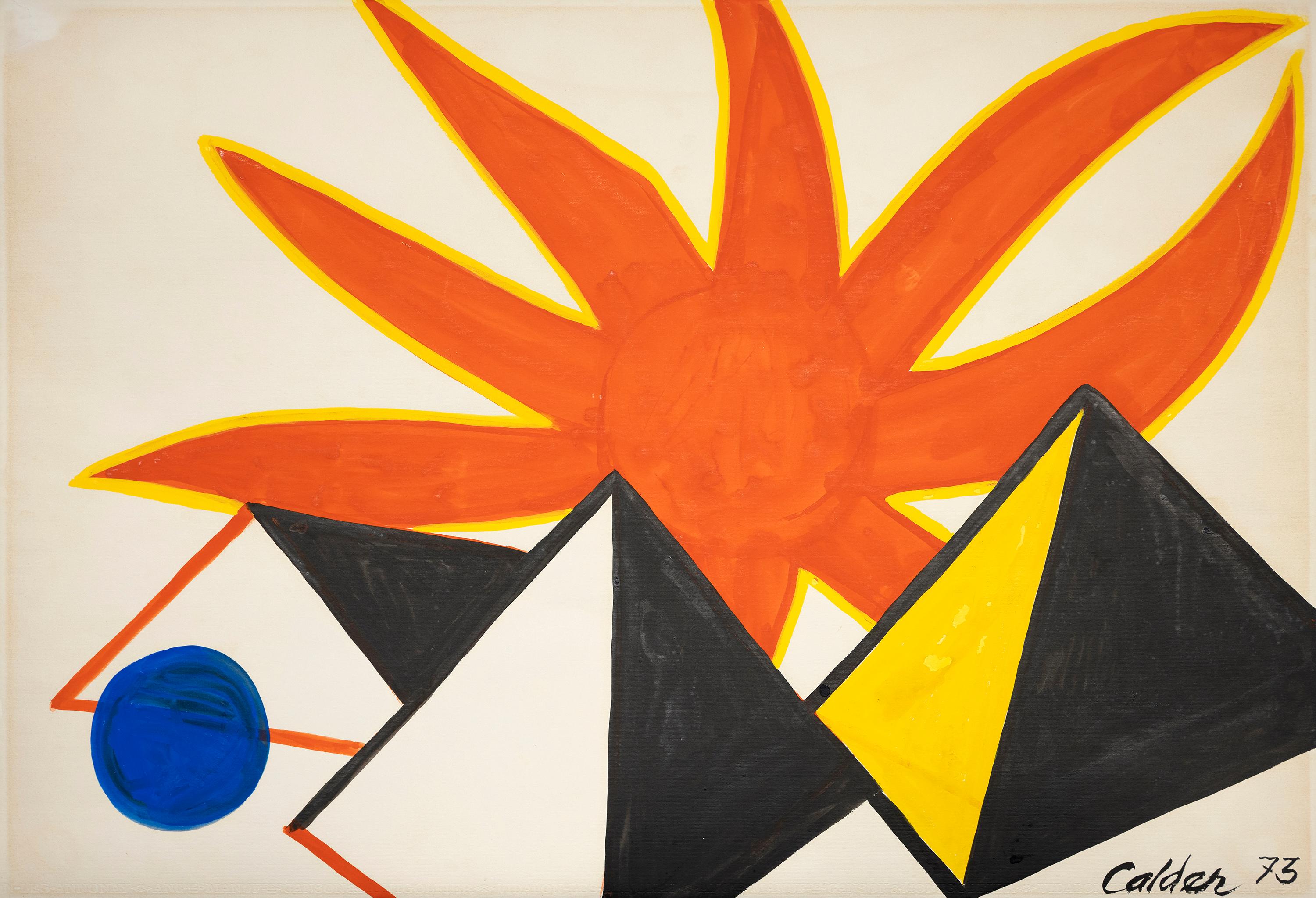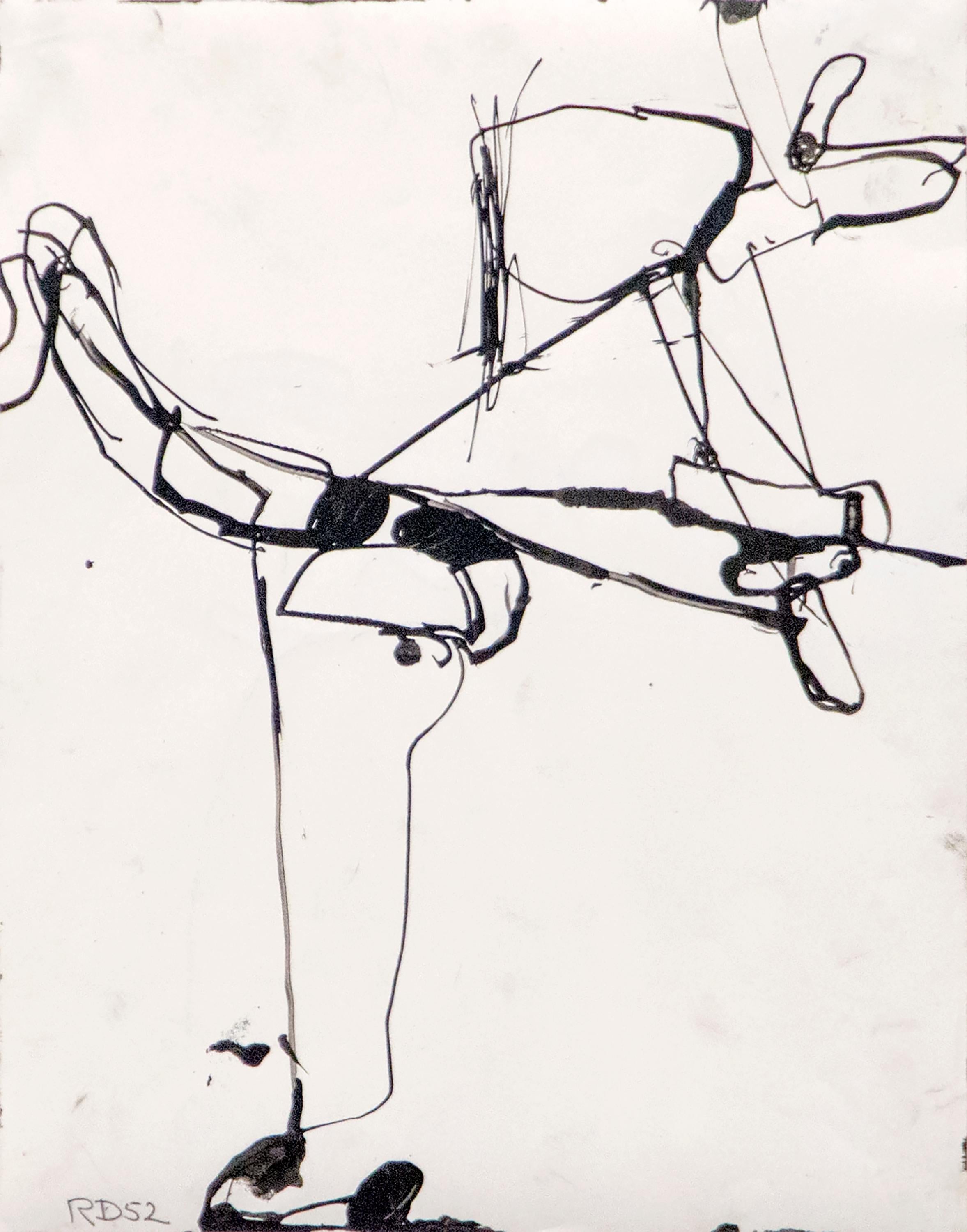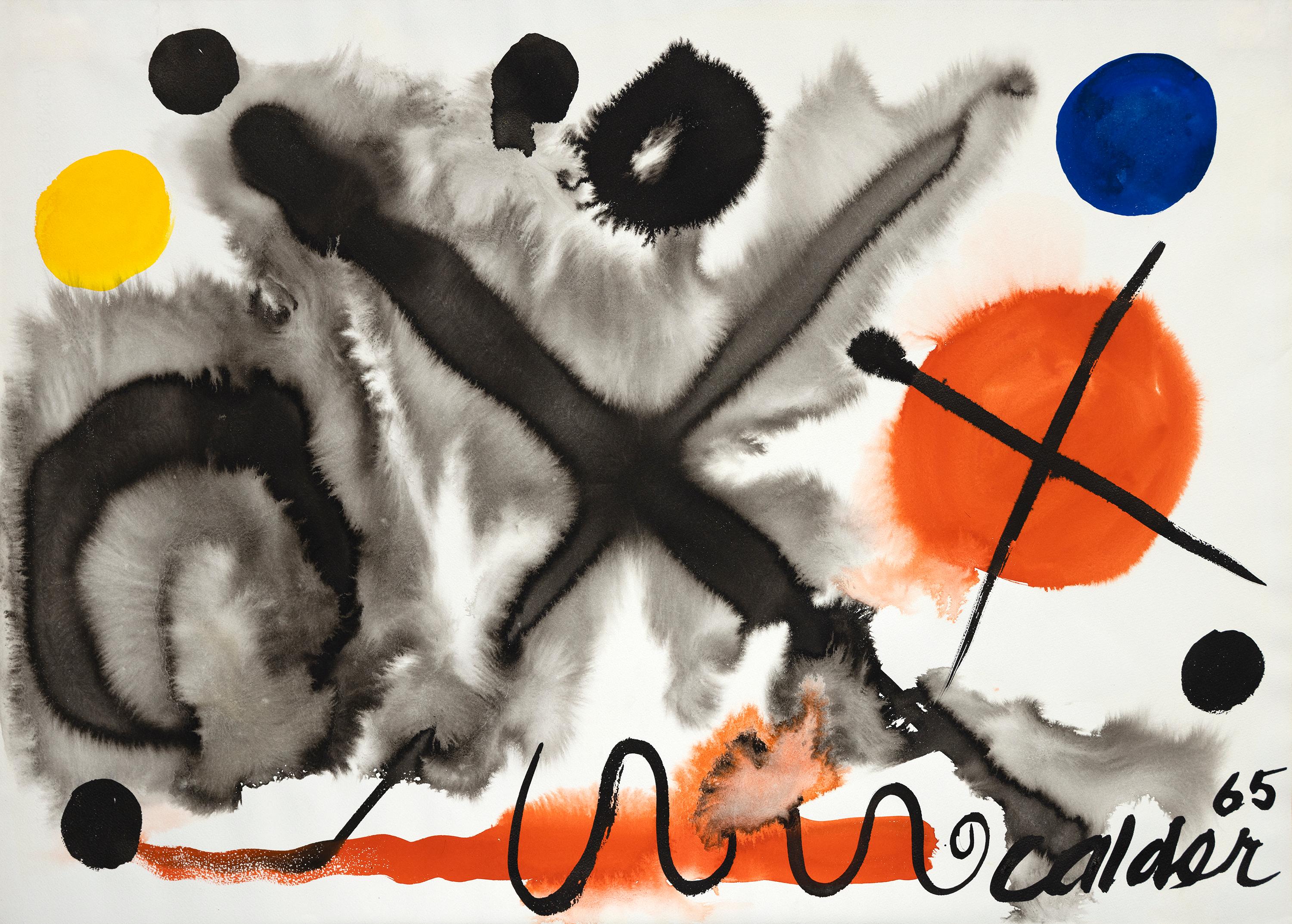Items Similar to Modern British, 1971 abstract ink on paper by Edmond Kapp, caricaturist, reds
Want more images or videos?
Request additional images or videos from the seller
1 of 11
Edmond Xavier KappModern British, 1971 abstract ink on paper by Edmond Kapp, caricaturist, reds1971
1971
About the Item
Edmond Xavier Kapp (British, 1890 – 1978)
No Question!
Ink on paper
Signed and dated ‘Kapp ‘71’ (lower left), titled on the reverse
14.3/4 x 11.7/8 in. (37.5 x 30.3 cm.)
Edmond Kapp was born in Islington, London, on 5 November 1890, of American and German Jewish parentage. He gave himself the middle initial ‘X’ – sometimes said to stand for Xavier – to distinguish himself from his father Emil Kapp, who was a wine merchant. However, his parents called him ‘Eddie’ while his wife and friends knew him as ‘Peter’.
During his early years, Kapp was continually ill and, while convalescing, entertained himself by drawing at home. As his health improved, he attended Dame Alice Owen’s School, Islington (1903-10), with periods at Berlin University (1909) and L’Institut Français pour les Etrangers, Paris (1909). He then read Languages at Christ’s College, Cambridge (1910-13), though spent most of his time writing and drawing.
Kapp took a studio in London, and worked intensively until the outbreak of the First World War, contributing to the Daily News, the Onlooker and other periodicals. During the war, he served as a 2nd Lieutenant in the Royal Sussex Regiment on the Western Front, and then in Intelligence, rising to the position of Staff Captain on Haig’s Staff. Finally, he founded and directed the Neutral Press Counter-propaganda Section.
In 1919, Kapp returned to London and, after abortive periods at three art schools, worked alone. In that year, he made his name with an exhibition of caricatures, held at Furst’s Gallery, London, and accompanied by a catalogue introduced by Max Beerbohm. This soon led to contracts with three London periodicals and a book of caricatures, Personalities, published by Martin Secker. Through the 1920s and 30s, his drawings of musicians and other personalities appeared in a wide variety of periodicals, most notably Time & Tide; were collected in further volumes; and were exhibited at the Leicester Galleries. He considered himself to be a ‘character-portraitist’, producing images of psychological not satirical power, and disliking the term ‘caricature’.
Between the wars, Kapp developed other aspects of his artistic talents, the desire to study and the search for subject matter often taking him abroad. For instance, work at the British Academy, Rome, under Antonio Sciortino, and with the American painter, Maurice Sterne, led him to produce his first oils (1923); while an introduction to the League of Nations in Geneva allowed him to use his new-found skill in lithography to produce portraits of twenty-five of its members (1933-35). This expansive and exploratory attitude to his work resulted in an increase in patrons and exhibitions, and in important artistic friendships, notably with Picasso (Picasso sat for Kapp in 1938).
Kapp worked as an Official War Artist during the Second World War, and then as an Official Artist to UNESCO. In the post-war period, he had a studio in Beausoleil, Alpes Maritimes, and explored abstract painting ‘passionately, though without dogmatism’ (Edmond Kapp, London: Whitechapel Art Gallery, 1961, page 8).
Kapp died on 29 October 1978. His sister – the artist Helen Kapp – had died earlier in the same month. The first of his three wives was Yvonne Kapp, biographer of Eleanor Marx and author of the memoir, Time Will Tell. They had visited Beerbohm in Rapallo during their honeymoon in 1923.
His work is represented in numerous public collections, including the National Portrait Gallery; The Barber Institute of Fine Arts (University of Birmingham), the Fitzwilliam Museum (Cambridge) and Manchester Art Gallery; and Albright-Knox Art Gallery (Buffalo).
- Creator:Edmond Xavier Kapp (1890 - 1978, British)
- Creation Year:1971
- Dimensions:Height: 14.75 in (37.47 cm)Width: 11.88 in (30.18 cm)Depth: 1 in (2.54 cm)
- Medium:
- Movement & Style:
- Period:
- Condition:In good condition, behind glass with a grey canvas mount and further grey slip, in a giltwood frame with white outer edge, chips and losses at leading edge.
- Gallery Location:Petworth, GB
- Reference Number:1stDibs: LU540313397422
About the Seller
4.9
Platinum Seller
These expertly vetted sellers are 1stDibs' most experienced sellers and are rated highest by our customers.
Established in 2010
1stDibs seller since 2017
230 sales on 1stDibs
Typical response time: 2 hours
- ShippingRetrieving quote...Ships From: Petworth, United Kingdom
- Return PolicyA return for this item may be initiated within 10 days of delivery.
More From This SellerView All
- Sir Eduardo Paolozzi industrial drawings, (2 drawings), 20th Century, ScottishBy Sir Eduardo PaolozziLocated in Petworth, West SussexSir Eduardo Luigi Paolozzi CBE RA (Scottish, 1924 – 2005) Industrial abstract; and another similar Pencil, crayon and ink on paper 8 x 11.1/2 in. (20.3 x 29 cm.) (both)Category
20th Century Abstract Geometric Abstract Drawings and Watercolors
MaterialsPaper, Crayon, Ink, Pencil
- Mid Century Cornish gouache abstract painting by William Black 'Doorway'Located in Petworth, West SussexWilliam Black (British, Fl. 1963 – 69) Doorway Ink and watercolour on paper Signed, inscribed and dated ‘Doorway William Black 64’ (lower edge) 7.1/2 x 4.7/8 in. (19.2 x 12.4 cm.) (to site edge) William Black is a little known and underrated member of the St Ives artist group who, having worked as an architect after the Second World War, went on to work as an artist following the inheritance of money in the early 1950s. He was a self taught artist, producing numerous deconstructivist sculptures in the 1960s. He moved to St Ives in Cornwall where he knew artists such as Ben Nicholson, Barbara Hepworth and Naum Gabo. There is a clear architectural element to the sculptures that he made . They illustrate an assemblage of fragmented shapes and forms of a deconstructivist nature. William Black’s artwork is very much rooted in the time and Cornish School so one can see elements from those such as Wilhelmina Barns Graham...Category
20th Century Abstract Abstract Drawings and Watercolors
MaterialsPaper, Ink, Watercolor
- Mid 20th Century Cornish Abstract gouache painting by William Black 'Landscape'Located in Petworth, West SussexWilliam Black (British, Fl. 1963 – 69) Landscape abstraction Watercolour and ink on paper Signed, inscribed and dated ‘Landscape abstraction William Black 63’ (lower edge) 8 x 11.1/4 in. (20.3 x 28.3 cm.) William Black is a little known and underrated member of the St Ives artist group who, having worked as an architect after the Second World War, went on to work as an artist following the inheritance of money in the early 1950s. He was a self taught artist, producing numerous deconstructivist sculptures in the 1960s. He moved to St Ives in Cornwall where he knew artists such as Ben Nicholson, Barbara Hepworth and Naum Gabo. There is a clear architectural element to the sculptures that he made . They illustrate an assemblage of fragmented shapes and forms of a deconstructivist nature. William Black’s artwork is very much rooted in the time and Cornish School so one can see elements from those such as Wilhelmina Barns Graham...Category
20th Century Abstract Abstract Drawings and Watercolors
MaterialsPaper, Ink, Watercolor
- Lynn Chadwick, British, ink abstract figurative painting, black wash, 1966Located in Petworth, West SussexLynn Russell Chadwick, CBE RA (British, 1914-2003) Abstracted figure Ink pen and wash Signed and dated `Chadwick 66’ (lower right) 24 x 18.1/4 in. (61 x 46.3 cm.) Lynn Chadwick was ...Category
20th Century Abstract Figurative Drawings and Watercolors
MaterialsPaper, Ink, Pen
- Francis Newton Souza, Indian 20th Century artist, nude abstract drawingBy Francis Newton SouzaLocated in Petworth, West SussexFrancis Newton Souza (Indian, 1924 – 2002) Odalisque Pen on paper 15.3/4 x 9.7/8 in. (40 x 25 cm.) Provenance: The artist’s wife Maria, Nee Figueiredo, gifted to her nephew We have 5 other similar examples by this artist all of the same size. Please go to Ottocento's storefront on 1st dibs for further information. These examples were saved from being burnt on a bonfire by the artist’s nephew. Maria, Souza’ wife was sick and tired of Souza’s affairs and was burning many of his studies in the garden when her nephew intervened. These studies are from those. Others saved at the same time were executed in 1952 and is highly likely that these are from the same period. Layered, dynamic, brutally humanistic, the paintings of Francis Newton Souza reveal an artist who never stopped experimenting throughout his six-decade career, perpetually seeking new modes and languages of painterly expression. A founder of the inestimably important Progressive Artists’ Group in Mumbai, he wrote the group’s manifesto and was a crucial intellect in the group’s formation and articulation—as, indeed, he was for Modern Indian art on the whole. He holds an unshakable place among India’s most important and influential Modern painters. Despite the vast sweep of painting styles encompassed by his oeuvre, Souza’s work is unified by an overt sensuality, sometimes violent, sometimes sexual, but devoted above all to the human body as a wild, fragile, noble and corruptible object. He is hardly the first Catholic-raised artist to fixate on the body. Nudes...Category
Mid-20th Century Abstract Expressionist Nude Drawings and Watercolors
MaterialsPaper, Pen
- British, Adrian Heath gouache painting, 1964 in creams and whitesBy Adrian Heath, 1920-1992Located in Petworth, West SussexAdrian Heath (British, 1920-1992) Squared foliage Gouache on paper Signed and dated `Heath 64’ (lower right) 29.1/2 x 21.3/4 in. (75 x 55.3 cm.) Born in Burma, Adrian Heath moved to...Category
20th Century Abstract Abstract Drawings and Watercolors
MaterialsPaper, Gouache
You May Also Like
- UntitledBy Franz KlineLocated in Beverly Hills, CAProvenance: Marlborough Gallery David McKee, Inc. Manny Silverman Gallery Private collection, Los AngelesCategory
1950s Abstract Expressionist Abstract Drawings and Watercolors
MaterialsPaper, Ink
- Wigwam rouge et jauneBy Alexander CalderLocated in Palm Desert, CA"Wigwam rouge et jaune" is a gouache on paper by Alexander Calder. The unique work is signed in the lower right, “Calder 65”. Although renowned for his innovative and groundbreaking...Category
1960s Abstract Abstract Drawings and Watercolors
MaterialsPaper, Ink, Gouache
- UntitledLocated in Palm Desert, CAA painting by Suh Se Ok (서세옥). An Untitled, abstract ink wash on paper painting by South Korean artist Suh Se Ok (서세옥), executed in a palette of pink and bla...Category
1960s Abstract Abstract Drawings and Watercolors
MaterialsPaper, Ink
- Three Pyramids + Blue BallBy Alexander CalderLocated in Palm Desert, CA"Three Pyramids + Blue Ball" is a gouache on paper by Alexander Calder. The work is signed in the lower right, "Calder 73”. Although renowned for his innovative and groundbreaking sculptures, Alexander Calder started his artistic career as an abstract painter, preferring to use gouache. What is gouache? Gouache is a water-soluble paint – a type of opaque watercolor. As Calder returned to gouache painting towards the end of his life, he was now armed with a lifetime of experience as a sculptor. He explored the three-dimensional vocabulary of sculptural forms he had developed onto the two-dimensional surface of the paper. Certain shapes and colors recur throughout his gouaches and sculptures. Circles, ovals, and other geometric forms dominate the space. There is the same sense of energy and fluidity. The shapes do not sit on the surface but vibrate giving a feeling of movement in contrast to the static nature of painting. Like his sculpture, Calder’s gouache...Category
1970s Abstract Abstract Drawings and Watercolors
MaterialsPaper, Ink, Gouache
- Untitled (Urbana Series)By Richard DiebenkornLocated in Palm Desert, CAA drawing by Richard Diebenkorn. This Untitled work from the Urbana Series is an ink of paper, abstract drawing by Post War, Bay Area Figurat...Category
1950s Abstract Expressionist Abstract Drawings and Watercolors
MaterialsPaper, Ink
- Two CrossesBy Alexander CalderLocated in Palm Desert, CA"Two Crosses" is a gouache on paper by Alexander Calder. The work is signed in the lower right, "Calder 65”. Although renowned for his innovative and groundbreaking sculptures, Alexander Calder started his artistic career as an abstract painter, preferring to use gouache. What is gouache? Gouache is a water-soluble paint – a type of opaque watercolor. As Calder returned to gouache painting towards the end of his life, he was now armed with a lifetime of experience as a sculptor. He explored the three-dimensional vocabulary of sculptural forms he had developed onto the two-dimensional surface of the paper. Certain shapes and colors recur throughout his gouaches and sculptures. Circles, ovals, and other geometric forms dominate the space. There is the same sense of energy and fluidity. The shapes do not sit on the surface but vibrate giving a feeling of movement in contrast to the static nature of painting. Like his sculpture, Calder’s gouache...Category
1960s Abstract Abstract Drawings and Watercolors
MaterialsPaper, Ink, Gouache
Recently Viewed
View AllMore Ways To Browse
Time Will Tell
Ink Press
British Modern Painters
Abstract Painting 1971
Vintage Writing Paper
20th Century Art On Paper British
1971 German
Drawings Of Musicians
Ink Stand
Picasso Ink On Paper
Dior 1971
Buffalo Drawing
Picasso Ink Drawings
Dior Patron
Red Post Modern Painting
Caricature Framed
Sator Gallery
Neutral Watercolor Paintings





